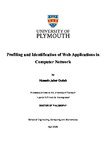Profiling and Identification of Web Applications in Computer Network
| dc.contributor.supervisor | Ghita, Bogdan | |
| dc.contributor.author | Oudah, Hussein | |
| dc.contributor.other | School of Engineering, Computing and Mathematics | en_US |
| dc.date.accessioned | 2020-11-27T13:56:22Z | |
| dc.date.available | 2020-11-27T13:56:22Z | |
| dc.date.issued | 2020 | |
| dc.identifier | 10509823 | en_US |
| dc.identifier.uri | http://hdl.handle.net/10026.1/16687 | |
| dc.description.abstract |
Characterising network traffic is a critical step for detecting network intrusion or misuse. The traditional way to identify the application associated with a set of traffic flows uses port number and DPI (Deep Packet Inspection), but it is affected by the use of dynamic ports and encryption. The research community proposed models for traffic classification that determined the most important requirements and recommendations for a successful approach. The suggested alternatives could be categorised into four techniques: port-based, packet payload based, host behavioural, and statistical-based. The traditional way to identifying traffic flows typically focuses on using IANA assigned port numbers and deep packet inspection (DPI). However, an increasing number of Internet applications nowadays that frequently use dynamic post assignments and encryption data traffic render these techniques in achieving real-time traffic identification. In recent years, two other techniques have been introduced, focusing on host behaviour and statistical methods, to avoid these limitations. The former technique is based on the idea that hosts generate different communication patterns at the transport layer; by extracting these behavioural patterns, activities and applications can be classified. However, it cannot correctly identify the application names, classifying both Yahoo and Gmail as email. Thereby, studies have focused on using statistical features approach for identifying traffic associated with applications based on machine learning algorithms. This method relies on characteristics of IP flows, minimising the overhead limitations associated with other schemes. Classification accuracy of statistical flow-based approaches, however, depends on the discrimination ability of the traffic features used. NetFlow represents the de-facto standard in monitoring and analysing network traffic, but the information it provides is not enough to describe the application behaviour. The primary challenge is to describe the activity within entirely and among network flows to understand application usage and user behaviour. This thesis proposes novel features to describe precisely a web application behaviour in order to segregate various user activities. Extracting the most discriminative features, which characterise web applications, is a key to gain higher accuracy without being biased by either users or network circumstances. This work investigates novel and superior features that characterize a behaviour of an application based on timing of arrival packets and flows. As part of describing the application behaviour, the research considered the on/off data transfer, defining characteristics for many typical applications, and the amount of data transferred or exchanged. Furthermore, the research considered timing and patterns for user events as part of a network application session. Using an extended set of traffic features output from traffic captures, a supervised machine learning classifier was developed. To this effect, the present work customised the popular tcptrace utility to generate classification features based on traffic burstiness and periods of inactivity for everyday Internet usage. A C5.0 decision tree classifier is applied using the proposed features for eleven different Internet applications, generated by ten users. Overall, the newly proposed features reported a significant level of accuracy (~98%) in classifying the respective applications. Afterwards, uncontrolled data collected from a real environment for a group of 20 users while accessing different applications was used to evaluate the proposed features. The evaluation tests indicated that the method has an accuracy of 87% in identifying the correct network application. | en_US |
| dc.description.sponsorship | Iraqi cultural Attache | en_US |
| dc.language.iso | en | |
| dc.publisher | University of Plymouth | |
| dc.rights | CC0 1.0 Universal | * |
| dc.rights.uri | http://creativecommons.org/publicdomain/zero/1.0/ | * |
| dc.subject | Traffic Classification | en_US |
| dc.subject | Tcptrace | en_US |
| dc.subject | web applications | en_US |
| dc.subject.classification | PhD | en_US |
| dc.title | Profiling and Identification of Web Applications in Computer Network | en_US |
| dc.type | Thesis | |
| plymouth.version | publishable | en_US |
| dc.identifier.doi | http://dx.doi.org/10.24382/775 | |
| dc.rights.embargoperiod | No embargo | en_US |
| dc.type.qualification | Doctorate | en_US |
| rioxxterms.version | NA |
Files in this item
This item appears in the following Collection(s)
-
01 Research Theses Main Collection
Research Theses Main



